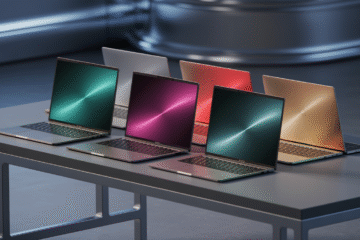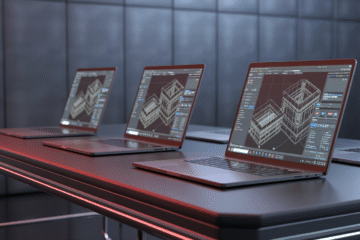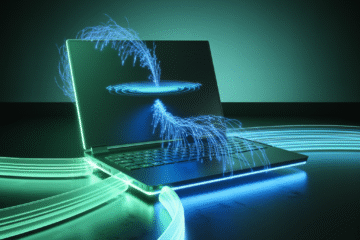Best Value Laptops for Beginners (2025)
Starting fresh with your first laptop can feel overwhelming: spec sheets, processor names, RAM numbers, SSD jargon… It’s a lot. The good news: you don’t need a powerhouse to learn, study, stream, and start creating. What you do need is reliability, a comfortable keyboard, battery life that lasts through classes or a full shift, and just enough performance headroom that your laptop doesn’t feel slow in six months.
This guide breaks down what truly matters for first-time buyers and ranks five excellent, beginner-friendly picks from 5 to 1 so you can buy with confidence and stay on budget.
What Beginners Should Prioritize (Before You Buy)
Focus on Everyday Speed, Not Benchmarks
Modern beginner use is mostly web (lots of tabs), documents, email, video calls, and light photo/video tinkering. For this, snappy single-core speed and fast storage matter more than high-end graphics. Aim for a recent-gen Intel Core/AMD Ryzen or Apple Silicon chip and NVMe SSD.
Memory (RAM): 8GB Works, 16GB Is Ideal
-
8GB: Basic school/work tasks, 10–15 browser tabs, streaming.
-
16GB: Smoother multitasking, future-proofing, and creative dabbling (simple edits, Canva, light coding).
Storage: Don’t Undershoot
256GB is workable for school and office files if you use cloud storage. 512GB gives breathing room for apps, offline media, and class projects. Always prefer SSD (NVMe) over HDD.
Display & Comfort
A 15–16″ panel is the beginner sweet spot for readability and split-screen study. Look for anti-glare, at least 250–300 nits, and good viewing angles (IPS). A comfortable keyboard and trackpad will do more for your grades and workflow than any flashy spec.
Battery Life & Ports
Plan for 7–10 hours of mixed use. USB-C charging is convenient; at least one USB-A port helps with older accessories. An HDMI output is great for projectors or a living room TV.
5: Acer Aspire 15 Slim Laptop – The Practical Starter
Why It’s Great for Beginners
The Acer Aspire 15 Slim nails the basics that matter most on day one: a roomy 15″ display, comfortable typing, and reliable performance at a friendly price. It’s a “no-drama” laptop easy to recommend to students and first-time buyers who want something simple that just works.
Everyday Experience
-
General use: Boots quickly, opens apps without delay, and handles school portals, Google Docs/Microsoft Office, and 10-20 tabs with ease (especially if you choose 16GB RAM).
-
Media & calls: Streams 1080p smoothly; decent webcam/mics for classes and check-ins.
-
Battery: Practical for all-day use for lectures if you keep the brightness moderate.
Best For
Students, office newcomers, and casual users who want a dependable 15″ laptop with zero learning curve.
Tips to Configure
-
Prioritize 8–16GB RAM and 256–512GB SSD.
-
If you’ll do light photo edits or code in VS Code, go for 16GB; you’ll feel the difference.
4: Lenovo IdeaPad Laptop – Budget-Smart Comfort
Why It’s Great for Beginners
Lenovo’s IdeaPad line focuses on comfortable keyboards, solid trackpads, and practical batteries, three things beginners appreciate from day one. It’s a value play that still feels refined.
Everyday Experience
-
Typing & navigation: Lenovo’s keyboard feel is consistently good, making essays and reports less tiring.
-
Productivity: Ideal for docs, spreadsheets, research tabs, and Zoom/Teams.
-
Portability: Slim enough for backpacks; hinge and chassis hold up to daily use.
Best For
Learners who type a lot, remote workers in their first role, and anyone who wants comfort without overspending.
Tips to Configure
-
Get IPS if available for better viewing angles.
-
Choose 16GB RAM if you run Slack/Teams + many browser tabs + Office apps together.
3: Dell Latitude 5400 Laptop – Business-Grade Reliability for Beginners
Why It’s Great for Beginners
The Dell Latitude 5400 comes from Dell’s business family, which means sturdier build quality, a spill-resistant keyboard, easy serviceability, and a design made for long life. For a beginner, that equals trust: less fiddling, more doing.
Everyday Experience
-
Stability: Runs cool and steady, even during long video calls or big spreadsheets.
-
Ports: Often includes full-size HDMI, multiple USB-A, USB-C/Thunderbolt (varies by config), and sometimes Ethernet, perfect for any classroom, office, or conference room.
-
Battery: Built for meeting-to-meeting endurance; still strong as a daily machine for students.
Best For
Beginners who want something tough and low-maintenance, perfect for internships, first jobs, and commuters who toss a laptop in the bag.
Tips to Configure
-
Look for SKUs with 16GB RAM and 512GB SSD.
-
If you find refurbished enterprise units, ensure that battery health and SSD condition are solid.
2: HP 15 Touchscreen Laptop – Touch Made Simple
Why It’s Great for Beginners
If you love the idea of scrolling, zooming, and annotating with your finger, the HP 15 Touchscreen offers an approachable way to get that without buying a 2-in-1. It retains a normal clamshell’s comfort while adding touch convenience.
Everyday Experience
-
Touch-friendly: Great for reading articles, zooming into PDFs, and using digital whiteboards in class.
-
Productivity & media: Smooth for Docs/Office, research tabs, streaming, and standard photo tweaks (think Canva).
-
Battery & comfort: Moderate brightness yields a full day for lectures and cafe study sessions.
Best For
Beginners who want the feel of a tablet for reading and marking up materials but still prefer a traditional laptop design for typing.
Tips to Configure
-
Touch panels often reflect more; pick anti-glare if available and avoid max brightness indoors.
-
Aim for 16GB RAM to keep touch apps + browser + video calls buttery.
1: Apple MacBook Air 13-Inch Laptop – The Effortless Beginner’s Champ
Why It’s Great for Beginners
The MacBook Air 13-inch (Apple Silicon) is the ultimate “don’t-think-about-it” choice: long battery life, silent fanless design, instant wake, and a brilliant screen. Even if you’ve never owned a Mac, the Air’s “just works” factor is on another level for new users.
Everyday Experience
-
Smoothness: Apps open instantly, typing is excellent, and the large trackpad sets the standard.
-
Battery: All-day, often two days, for note-taking, web research, and streaming at reasonable brightness.
-
Beginner synergy: If you use an iPhone, AirDrop, iCloud, and clipboard sharing feels like magic for projects and photos.
Best For
First-time buyers who value stability, quiet, and portability, and want a laptop that stays fast for years.
Tips to Configure
-
Memory: 8GB is usable; 16GB is better for creative dabbling or heavy multitasking.
-
Storage: 512GB internal + iCloud or an external SSD is a great combo.
-
For desk use, add a USB-C hub and a 24–27″ external monitor to turn it into a mini desktop.
Which One Should You Buy? (Quick Scenarios)
I’m a student on a tight budget.
Pick the Acer Aspire 15 Slim or the Lenovo IdeaPad with 16GB RAM. You’ll get comfort and reliability without paying for extras you won’t use.
I want business-grade durability.
Choose Dell Latitude 5400. It’s built tough, has more ports, and is easy to service—great for years of use.
I really want touch controls, but not a 2-in-1.
Go HP 15 Touchscreen. It’s the simplest path to tap/zoom/annotate in a normal laptop form factor.
I want the smoothest beginner experience and best battery.
Apple MacBook Air 13-inch. Silent, long-lasting, and consistently responsive, ideal for learning and growing into new skills.
Beginner Buying Tips (That Actually Help)
Start with 16GB RAM if you can
Browsers, video calls, and chat apps together can chew through memory. 16GB keeps everything feeling snappy and reduces random slowdowns.
Get SSD, not HDD
All five choices here come with SSDs good. NVMe is the fastest. This single spec affects nearly everything you do.
Screen comfort beats ultra-high resolution
A clear IPS panel with anti-glare and decent brightness is more valuable than chasing 4K. Your eyes and battery will thank you.
Learn your backup plan on day one
Turn on cloud sync (iCloud, Google Drive, OneDrive) and keep a small external SSD for important projects. Backups save grades—and jobs.
Keep the desk setup simple
A basic 24–27″ monitor, USB-C hub, and keyboard/mouse transform any of these laptops into a comfortable workstation for long sessions.
Skill Growth: What Your First Laptop Should Handle
Study & Research
Multiple browser profiles/tabs, citation managers, PDF viewers, and note-taking apps like Notion or OneNote, all five laptops can handle this gracefully with 16GB RAM.
Content Basics
Canva, lightweight photo edits in Photos/Lightroom, short video snippets for class or social, and podcast basics (two to four tracks). Prefer the MacBook Air or a Windows model with 16GB for smoother previews.
Early Coding & Data
VS Code, Python basics, simple data notebooks, and small web projects. The Latitude’s extra ports help when you add a second monitor and external storage; the Air’s silent design is ideal for long study nights.
Communication & Collaboration
Zoom/Teams/Meet, Slack/Discord, and real-time docs no problem. If you attend long calls daily, prioritize a model with a 1080p webcam and consider a headset for clarity.
Frequently Asked Questions (Beginners)
Is 8GB RAM okay in 2025?
For very light use, yes. But 16GB is a safer baseline, so your laptop stays snappy as your workload grows.
Do I need a dedicated GPU?
Not for beginners. Integrated graphics in modern CPUs and Apple Silicon are plenty for school, office, and light creative tasks.
Windows or macOS?
Both are excellent. Windows offers a wider hardware variety and ports. macOS (MacBook Air) is famously smooth with a stellar battery. Choose based on your comfort and the apps you need.
How much storage should I buy?
256GB works with cloud storage; 512GB is more comfortable for offline media and projects. You can always add a small external SSD later.
Should I buy refurbished?
Business-grade refurbs (like Latitude) can be a fantastic value, just check the seller’s warranty, battery health, and SSD condition.
Final Verdict
If you want the easiest beginner experience with incredible battery and near-zero fuss, the Apple MacBook Air 13-inch is the clear winner. For Windows beginners who want a touchscreen without jumping to a 2-in-1, the HP 15 Touchscreen is a friendly, versatile pick. Prefer business-grade durability and ports that fit every conference room? Go Dell Latitude 5400. On a tighter budget and after a comfortable keyboard with a simple setup, the Lenovo IdeaPad and Acer Aspire 15 Slim deliver exactly what you need no drama, solid value.
Whichever you choose, prioritize 16GB RAM, an NVMe SSD (256–512GB+), a clear anti-glare screen, and a good keyboard/trackpad. Those four decisions matter more than any flashy spec and will keep your laptop feeling fast, friendly, and future-ready as you grow.



0 Comments